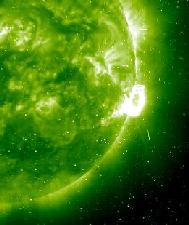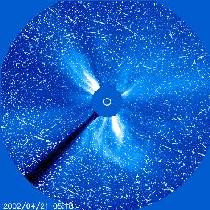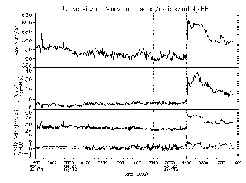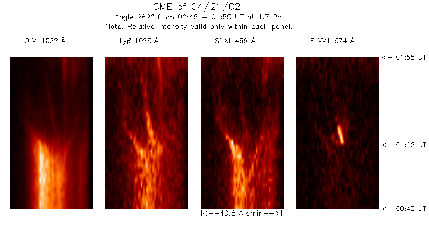Large X-1 Flare Explodes (April 23, 2002)


|
Early on April 21, 2002, a large (X-1) flare and a partial halo
coronal mass ejection (CME) exploded out from the Sun from near its
west (right) limb. At 5:36 UT, not long after the flare, one can see
bright loops in the ultraviolet EIT 195 ANSGTROM image near the
source of the flare. One can also observe the pronounced proton storm
of high-energy particles at about the same time in the LASCO C3 image
taken in visible light. The accompanying coronal mass ejection can
also be seen in the image and movie as clouds of expanding particles.
The front edge of the CME reached Earth just two days later and did
generate some auroral activity. The proton storming continued for
well over two days, though by April 23 is now showing signs of
lessening.
 CME shock front as it passes the SOHO spacecraft early on April 23, 2002.
 UVCS images represent observations taken at 1.7 solar radii from 00:45 UT to 01:55 UT. Each UVCS image is a time sequence of 32 exposures each lasting 120 seconds. The horizontal dimension is the length of the slit (40.6 arcmin) which covers position angles from 232 to 302 degrees. At the start of observations, the bright, relatively stable corona above this active region was present until the CME started to pass at 01:16 UT. The corona was disrupted by the CME (see near the center of the images). The data indicate that this CME was composed of hot material, compared to CMEs resulting from prominence eruptions. Spectral lines from ionized gas hotter than the average corona (e.g., Fe XVIII 974 A, 6 million degrees) were present which may have important information about the mechanisms associated with this X-1 flare. The data also indicate (not depicted in these images) that the CME was composed of twisting materials. Previous Picks of the Week SOHO began its Weekly Pick some time after sending a weekly image or video clip to the American Museum of Natural History (Rose Center) in New York City. There, the SOHO Weekly Pick is displayed with some annotations on a large plasma display. If your institution would also like to receive the same Weekly Pick from us for display (usually in Photoshop or QuickTime format), please send your inquiry to steele.hill@gsfc.nasa.gov. |


